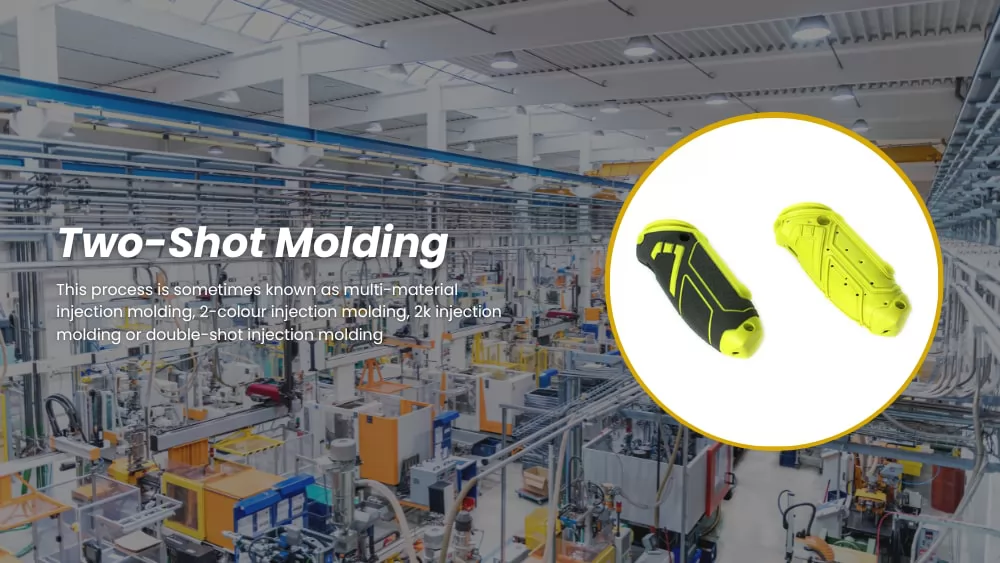
2 shot injection molding is one of such advances in conventional injection molding. It is adaptable to the production of complex designs using a wide range of materials. 2 shot injection molding achieves high quality of products. It is a well-established technology in the manufacturing industry.
Therefore, this article aims to provide a detailed overview of two-shot injection molding to help you understand, and we will also discuss the advantages and disadvantages of these technologies.
Article Directory
- What is Two-Shot Molding?
- Two-Shot Molding Process
- Advantages of Two-Shot Molding
- Disadvantages of Two-Shot Molding
- Two-Shot Injection Molding Applications
- Two-Shot Molding Mold and Product Design
- How can Two-Shot Molding Enhance Your Product?
- General Considerations for Two-Shot Molding
- Related Topic: What is Overmolding?
- What Are the Different Types of Two-Shot Injection Molding?
- What Materials Are Used in Two-Shot Injection Molding?
- Two-Shot Molding vs Overmolding
- Terminology for Two-Shot Molding
- Conclusion
What is Two-Shot Molding?
This process is sometimes known as multi-material injection molding, 2-colour injection molding, 2k injection molding or double-shot injection molding. This injection molding process involves the molding together of two separate plastic resins in a single machining cycle. As a result, engineers can easily create multi-material and multi-colored parts without extra machining steps.
Two-shot injection molding offers freedom to the designer, as it negates the use of multiple steps in manufacturing. It provides molding manufacturers with many advantages such as lower manufacturing costs, better aesthetics and ergonomics, superior mechanical bonds, and lower production times. Many products, such as toys, automotive parts, medical equipment, containers, and toiletries can be manufactured using this method.
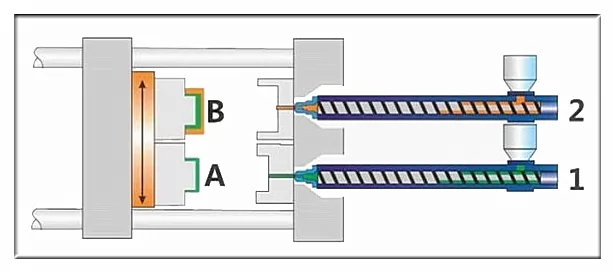
Two-Shot Molding Process
The two-shot molding process involves several distinct steps that ensure precise and efficient production. Here's an overview of the typical two-shot molding process:
-
Mold Preparation: The mold, also referred to as the tool or die, is designed and prepared to accommodate the two-shot molding process. This includes incorporating the necessary features, such as multiple cavities, slides, or rotating cores, to facilitate the production of complex parts.
-
Material Selection: Two compatible materials with contrasting colors or properties are chosen for the two-shot molding process. These materials should bond well with each other to ensure a strong and durable final product.
-
Injection Phase: The two-shot molding machine starts by injecting the first material, often referred to as the substrate or base material, into the mold cavity. Once the first shot is complete, the machine repositions the mold to allow for the injection of the second material, known as the overmold or topcoat.
-
Overmolding Phase: The machine injects the second material over the first shot, ensuring that the two materials bond together effectively. The mold is then kept closed to allow for the curing or cooling of the materials, depending on their specific requirements.
-
Ejection and Finishing: After the materials have solidified, the mold opens, and the finished two-shot molded part is ejected. The part may undergo additional post-processing steps, such as trimming, polishing, or assembly, to achieve the desired final appearance and functionality.
Advantages of Two-Shot Molding
Two-shot molding offers several advantages over traditional injection molding techniques. Let's explore some of the key benefits:
-
Enhanced Design Capabilities: Two-shot molding allows for the creation of complex parts with multiple colors, textures, or material combinations in a single manufacturing cycle. This opens up a wide range of design possibilities and enables the production of visually appealing and functionally superior products.
-
Improved Efficiency: By integrating multiple production steps into a single process, two-shot molding eliminates the need for separate operations, such as manual assembly or secondary overmolding. This streamlines production, reduces labor costs, and increases overall efficiency.
-
Enhanced Product Performance: Two-shot molding enables the combination of different materials with distinct properties, such as hardness, flexibility, or chemical resistance, into a single part. This results in improved product performance, durability, and functionality.
-
Cost Savings: While the initial setup costs for two-shot molding may be higher than traditional injection molding, the overall cost savings can be significant. The elimination of additional manufacturing steps, reduced assembly requirements, and improved production efficiency contribute to lower production costs in the long run.
-
Reduced Waste: By integrating two materials into a single part, two-shot molding minimizes material waste compared to traditional manufacturing methods that require separate processes for different components.
Disadvantages of Two-Shot Molding
Despite its numerous advantages, two-shot molding also has some limitations and considerations. Let's explore the potential disadvantages:
-
Complex Tooling: Two-shot molding requires specialized molds with additional features and complex designs to accommodate the dual material injection. This can increase tooling costs and lead to longer lead times for mold production.
-
Material Compatibility: The materials used in two-shot molding must be carefully selected to ensure compatibility and adhesion between the different components. Incompatibility issues may arise if the materials have significantly different melting temperatures, shrinkage rates, or chemical properties.
-
Process Complexity: Two-shot molding is a more intricate and involved process compared to traditional injection molding. It requires precise control of injection parameters, material flow, and curing conditions to achieve optimal results. This complexity may necessitate skilled operators and potentially longer cycle times.
-
Limited Material Options: The selection of materials for two-shot molding is more restricted compared to traditional injection molding. The compatibility requirements and the need for proper bonding between materials can limit the available options for achieving desired material combinations.
Despite these considerations, the benefits of two-shot molding often outweigh the disadvantages, making it a popular choice for many manufacturing applications.
Two-Shot Injection Molding Applications
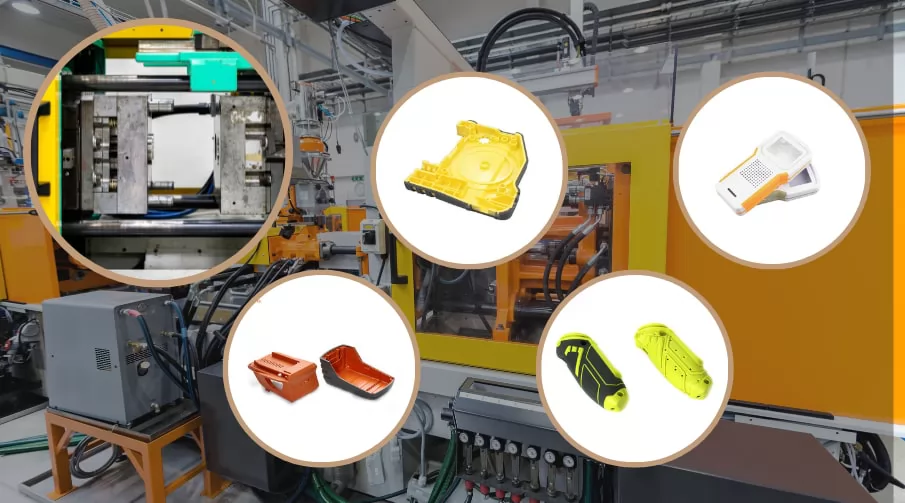
Two-shot molding finds applications in various industries where the integration of multiple materials or colors is crucial. Here are some common areas where two-shot injection molding is widely used:
-
Automotive Industry: Two-shot molding is extensively utilized in the automotive sector for producing interior and exterior components. This includes multi-colored instrument panels, door handles with soft-touch grips, buttons, knobs, and other intricate parts that require both aesthetic appeal and functional performance.
-
Consumer Electronics: Two-shot molding is employed in the production of consumer electronics, such as mobile phone cases, laptop keyboards, remote controls, and wearable device components. The process allows for the integration of different materials, textures, and colors, enhancing the visual appeal and user experience of these products.
-
Medical Devices: The medical industry benefits from two-shot molding by creating devices with improved functionality and patient comfort. Examples include ergonomic handles for surgical tools, overmolded seals for medical devices, and components with varying hardness for medical equipment.
-
Household Appliances: Two-shot molding is utilized in the manufacturing of household appliances, like refrigerator handles, control panels, and touch-sensitive buttons. The process enables the incorporation of contrasting colors, soft grips, and tactile surfaces, enhancing the overall aesthetics and user interaction.
-
Cosmetics and Packaging: Two-shot molding is also prevalent in the cosmetics and packaging industry. It allows for the creation of visually appealing packaging designs, such as caps with integrated seals, multi-colored containers, and custom-shaped cosmetic product casings.
Two-Shot Molding Mold and Product Design
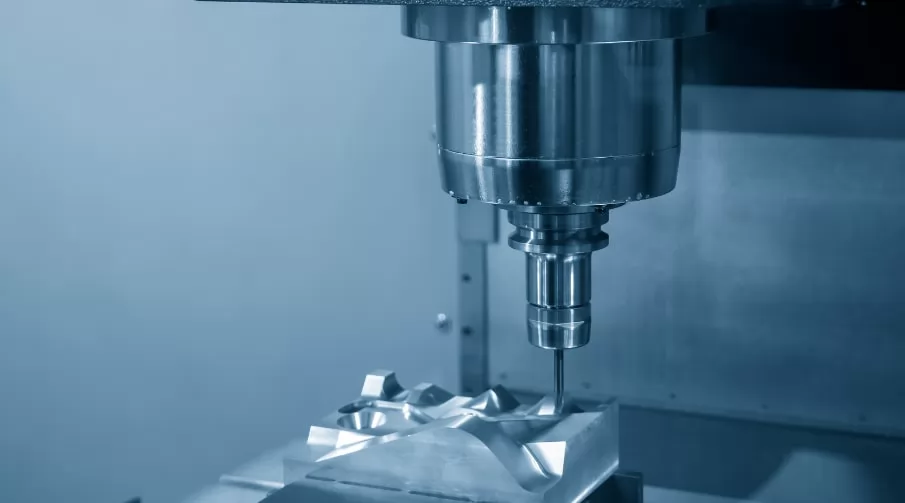
Successful two-shot molding relies on thoughtful mold and product design considerations. Here are key factors to keep in mind:
-
Part Design: Optimal part design is essential to ensure proper material flow, adhesion, and functionality. Designers should consider factors such as material compatibility, part geometry, draft angles, and wall thickness uniformity. Prototyping and simulation tools can aid in validating the design before committing to mold production.
-
Mold Design: Two-shot molds require careful consideration of features like parting lines, gating locations, and material transition areas. Proper cooling channels should be incorporated to control temperature differentials and ensure uniform part curing. The mold should also allow for easy material purging and maintenance.
-
Material Selection: Choosing compatible materials is crucial for achieving strong adhesion and a reliable bond between the substrate and overmold. Materials should have similar melt temperatures, shrinkage rates, and chemical properties to minimize potential issues during the molding process.
-
Injection Sequence: Determining the optimal injection sequence is vital to ensure a successful two-shot molding process. Sequential injection involves injecting the first material and allowing it to partially solidify before injecting the second material. Simultaneous injection, on the other hand, involves injecting both materials simultaneously. The selection depends on factors such as material compatibility, part design complexity, and desired bond strength.
-
Quality Control: Implementing robust quality control measures is essential to verify the integrity of two-shot molded parts. This includes monitoring process parameters, conducting regular inspections, and performing functional testing to ensure dimensional accuracy, adhesion strength, and overall part quality.
How Can Two-Shot Molding Enhance Your Product?
Two-shot molding offers several ways to enhance your product's performance, aesthetics, and functionality:
-
Aesthetic Appeal: By integrating multiple colors, textures, or materials into a single part, two-shot molding allows for unique and visually appealing designs that stand out in the market. This can help create a distinctive brand identity and attract customers.
-
Improved Ergonomics: Two-shot molding enables the incorporation of soft-touch grips, ergonomic contours, and tactile surfaces, enhancing the comfort and usability of products. This is particularly beneficial for handheld devices, consumer electronics, and tools.
-
Enhanced Durability: The combination of different materials with complementary properties enhances the durability and longevity of products. For example, an overmolded part can have a soft outer layer for impact resistance while maintaining a rigid inner structure for structural integrity.
-
Function Integration: Two-shot molding allows for the integration of multiple functions into a single part, reducing the need for assembly or additional components. This streamlines manufacturing processes, reduces assembly costs, and improves product reliability.
-
Brand Differentiation: Utilizing two-shot molding to create unique designs and innovative features can set your products apart from competitors. This can contribute to brand differentiation, customer loyalty, and increased market share.
General Considerations for Two-Shot Molding

When venturing into two-shot molding, there are some general considerations to keep in mind:
-
Partner with an Experienced Manufacturer: Two-shot molding requires specialized knowledge and expertise. Collaborate with a reputable manufacturer with experience in this process to ensure successful implementation and high-quality results.
-
Material Testing and Validation: Conduct thorough material testing and validation to ensure compatibility, adhesion, and performance. This includes evaluating material properties, conducting bonding tests, and verifying the suitability of materials for the intended application.
-
Prototype and Testing: Prioritize prototyping and testing to validate the design, functionality, and manufacturability of two-shot molded parts. This iterative process allows for adjustments and improvements before finalizing the mold design and scaling up production.
-
Quality Control and Inspection: Implement robust quality control measures throughout the production process. Regular inspections, dimensional checks, and functional testing are essential to ensure adherence to specifications and maintain consistent quality.
-
Continuous Process Optimization: Continuously strive to optimize the two-shot molding process by monitoring and analyzing key performance indicators, such as cycle time, scrap rates, and part quality. Seek opportunities to improve efficiency, reduce costs, and enhance overall productivity.
Related Topic: What is Overmolding?
Overmolding is a specialized form of custom injection molding, offering a seamless fusion of multiple materials within a single part or product. It involves the application of a thin, pliable thermoplastic elastomer (TPE) or other materials onto a rigid plastic-base component. This technique can be executed through either a single-shot (insert molding) or two-shot (multiple-shot molding) process.
This method holds significant advantages for various manufacturing and industrial applications. It facilitates the creation of high-quality, functional components that are both durable and visually appealing. Moreover, overmolding is frequently employed in plastic prototype development and the production of specific sub-sections of components. In essence, overmolding stands as a versatile and efficient solution for integrating different materials, enhancing product functionality, and achieving desired aesthetics.
What Are the Different Types of Two-Shot Injection Molding?
-
Cavity Sliding Structure: This is a type of two-shot mold structure.
-
Rotary Platen Two-Shot Mold: This involves rotating the mold between the injection of the two materials.
-
Core Toggle Two-Shot Mold: This type uses a 45-degree nozzle.
-
Seesaw Two-Shot Mold: In this structure, the mold opens after the second injection.
-
Index Plate Two-Shot Mold: This is another variation of two-shot molding.
What Materials Are Used in Two-Shot Injection Molding?
Two-shot injection molding typically uses two or more types of plastic raw materials, depending on the specific requirements and properties of the finished part, such as strength, wear resistance, temperature resistance, color and surface properties, etc. Here are some of them:
-
Polycarbonate (PC)
-
Acrylonitrile Butadiene Styrene (ABS)
-
Polyphenylene Oxide (PPO)
-
Polyethylene Terephthalate (PET)
-
Polyurethane
-
Thermoplastic Elastomers (TPEs)
-
Silicone
-
Aluminum
-
Brass
-
Steel
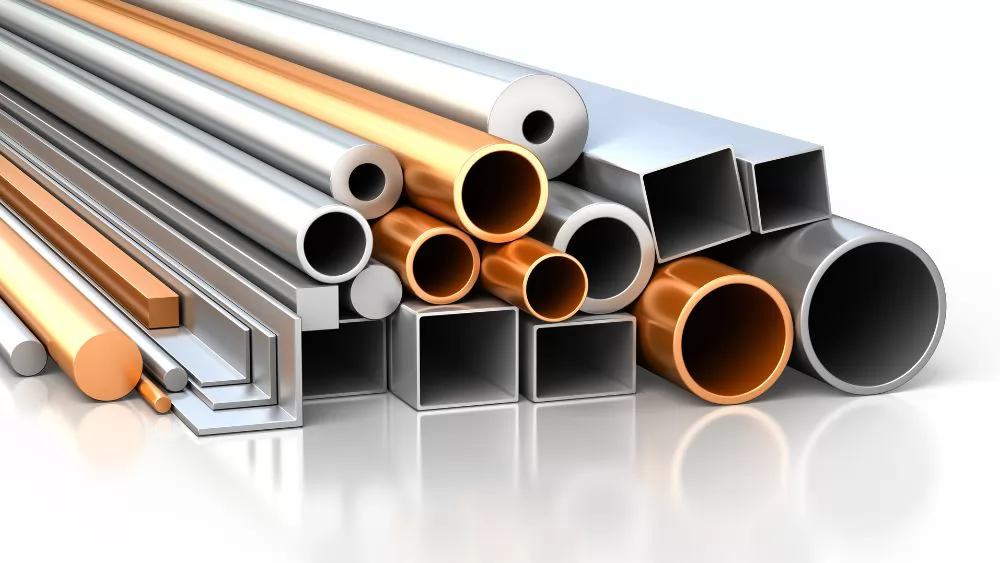
Two-Shot Molding vs Overmolding
While two-shot molding and overmolding are often used interchangeably, there are differences between the two processes:
-
Material Integration: Two-shot molding involves injecting two different materials into a single mold, sequentially or simultaneously, to create a part with distinct layers or regions. Overmolding, on the other hand, typically refers to the process of injecting a second material onto a preformed substrate or base material.
-
Process Complexity: Two-shot molding is generally considered more complex than overmolding due to the need for specialized equipment, tooling, and precise control over material flow and bonding. Overmolding is comparatively simpler and can be achieved with conventional injection molding machines.
-
Design Flexibility: Two-shot molding offers greater design flexibility as it allows for the integration of multiple colors, textures, or material combinations in a single part. Overmolding, while providing some design versatility, is more limited in terms of the number of materials that can be combined.
-
Bonding Strength: Two-shot molding typically produces stronger material bonds as the two materials are injected together, ensuring good adhesion and chemical compatibility. Overmolding relies on the bonding strength between the preformed substrate and the overmold material, which may not be as strong as the bonds in two-shot molding.
-
Cost Considerations: Two-shot molding generally involves higher initial setup costs due to specialized equipment and tooling requirements. Overmolding, being a simpler process, can be more cost-effective for certain applications that require a single material layer over a base substrate.
Observing the differences between two-shot injection molding and overmolding, we can discern that overmolding is suitable for small-batch production, while two-shot injection molding is ideal for large-scale production. This is because two-shot injection molding initially requires high injection molding costs and utilizes expensive molds. Therefore, for larger-scale production, it's preferable to opt for this process.
Overmolding can be accomplished on a common standard injection molding machine, making it suitable for producing parts with low precision requirements. Thus, for manufacturers with small-scale operations who are temporarily unable to invest in large machining tools, overmolding is a favorable choice.
Understanding the differences between two-shot molding and overmolding allows you to choose the most suitable process based on your specific product requirements and design goals.
Terminology for Two-Shot Molding

When delving into the world of two-shot molding, familiarize yourself with the following key terminology:
-
Substrate: The first material injected into the mold, which forms the base layer of the two-shot molded part.
-
Overmold: The second material injected over the substrate, creating additional layers, colors, or functional features.
-
Bonding: The process by which the substrate and overmold materials adhere to each other to form a strong and reliable bond.
-
Gate: The entry point through which the molten material enters the mold cavity during the injection process.
-
Parting Line: The visible line or seam on the two-shot molded part where the mold halves meet.
-
Shot Size: The amount of material injected into the mold during each injection cycle, typically measured in grams or ounces.
-
Cavity: The void or empty space within the mold where the molten material fills to form the desired part shape.
-
Core: A component of the mold that creates internal features or shapes within the part.
-
Flash: Excess material that seeps out from the mold and forms thin, unwanted protrusions on the molded part.
-
Cycle Time: The total time required to complete one injection molding cycle, including injection, cooling, and ejection of the part.
Conclusion
Two-shot injection molding is a versatile and advanced manufacturing process that provides superior design flexibility and improved product performance. By integrating multiple materials or colors into a single part, manufacturers can create visually appealing, functional and durable products across a variety of industries. With its advantages in aesthetics, functionality and efficiency, overmolding is revolutionizing plastic part production.
While overmolding has specific considerations and complexities, working with an experienced manufacturer and following best practices ensures a successful implementation. We are an injection molding machine manufacturer from China, producing plastic molds and injection molds, also providing high-quality injection molding services in China. Contact us now to start the next stage of your injection molding project!


